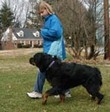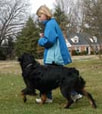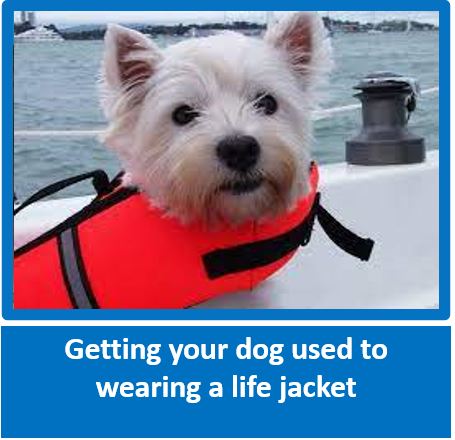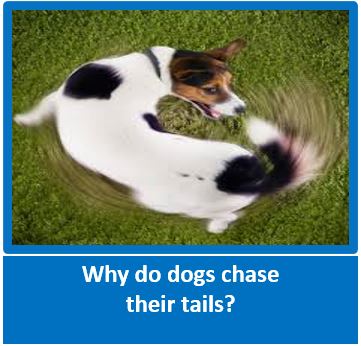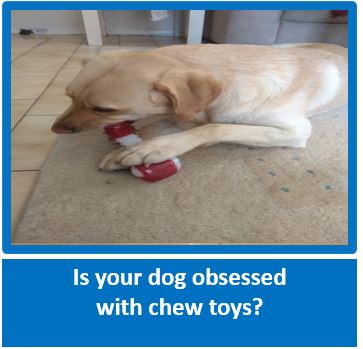
If you want to do Clicker training or teach your dog tricks, we have 2 great options for you to choose from. We also have a huge variety of top name, top quality dog toys to suit even the fussiest pet, as well as toys for cats and your small critters. It does not stop there - we have just about everything else you will need for your pet, including the small critters. www.mcmac.co.za
Clicker Training On-Line Course by Mary Woodward
www.greenwooddogs.com : www.clickerlessons.com
Lesson Six
Loose Leash Walking
When I ask my dog school students which behaviors they are having trouble with, pulling on the leash ties with jumping up. It's no wonder that it's such a problem, as most owners have been unwittingly teaching their dog to pull ever since they brought him home! Why? Because dogs do what works. Simple. For many dogs, they have always dragged their owners places. Why do they do this? First of all, because it WORKS. Don't they always get where they wanted to go by dragging? Also, dogs have a very strong urge to resist pressure. When they feel the pressure on their necks, they about can't help but pull against it. You need to stop making pulling work for him.
Old Fact: pulling gets me to the park New Fact: pulling doesn't get me to the park!
So, all of that time you were letting yourself be dragged along, you were actually teaching him to pull you! Please realize that to successfully re-train him not to pull, you can't train some of the time & let him pull the rest of the time. You HAVE to make the committment to only train the behavior you prefer! At the bottom of the page I have some advice for how to get places while you are still working on this.
Ready to start? Get yourself ready - have a whole bunch of tiny treats (or one really big treat he can nibble) and a good leash. I recommend a short one (4 - 6') that is comfortable to hold. Put the Flexi-leashes away for now. Have the treats in the hand next to the dog. Hold the leash in your other hand, gathered up so that there is just a bit of slack. It is very important that it not be tight.
Okay, now start out with your dog sitting or standing at your side. Use a treat to lure him around to that position if needed. Let him see the treats you are holding in your hand.Say his name once to get his attention, then step off, praising happily. Take JUST 1-2 steps, then pause in mid stride to deliver a treat. (We no longer have people use the clicker for this in class - it was difficult for many people to coordinate everything, and we found that the dogs pick this up very easily without the clicker.)
Wait just long enough for him to gobble down the treat, then take 2 more steps and give another treat. Be sure that you are getting the treat to the dog quickly, so that he is still by your side when he gets it. If he runs out in front, then lure him back to your side before giving him the treat. CAUTION!! Don't go more than 2 steps for now! You must hold your dog's attention for this to work and that is so much easier for only 2 steps. Be sure to praise enthusiastically the entire time he at your side! If you need to turn around, then lure your dog around by holding a treat right in front of his nose, make the turn, pause to give the treat (get it to his mouth really fast - you want him to still be at your side when getting it), then move on. However - be careful to only use the luring on the about turns and when you have to go past any distractions your dog isn't ready for. Otherwise, when you are walking you must keep the treats away from the dog's nose. He should NOT be walking along, simply staring at a treat you are dangling. So, when you are moving forward, a few steps at a time, keep your treat hand up by your waist and out of his sight.
If at any point he runs ahead, then lure him back before stepping off again. If this is happening often, then you need to take fewer steps before delivering a treat. Also try to walk quickly and praise - both of those things will go a long way towards keeping your dog's focus on you.
If you have a very small dog or puppy, you might find it gets old bending down to deliver the treat. You can try using a long wooden spoon dipped in peanut butter or soft cheese. You just hold it up and out of the way while walking, then dip it down so your dog just has to reach up a bit for a quick lick before you continue on. Thanks to trainer Patty Ruzzo for sharing that tip - one of her own students thought of it!
When your dog is consistently walking nicely for 2 steps, then begin requiring more. 4 steps, then 6 steps, etc. before you pause to treat. Keep it fun - make a lot of turns and circles.
It is essential that you use good enough treats, work in a distraction-free area at first, and that you praise the WHOLE time you are pleased with your dog's behavior. You cannot praise enough! Usually a happy, high pitched voice works well. Try to sound a little silly! If you become quiet, you are likely to lose your dog's attention. You are competing against the entire environment for his attention so you had better be pretty darn interesting! It is far, far easier to capture his attention before you start out & keep it than to try to capture it back again & again.
When I ask my dog school students which behaviors they are having trouble with, pulling on the leash ties with jumping up. It's no wonder that it's such a problem, as most owners have been unwittingly teaching their dog to pull ever since they brought him home! Why? Because dogs do what works. Simple. For many dogs, they have always dragged their owners places. Why do they do this? First of all, because it WORKS. Don't they always get where they wanted to go by dragging? Also, dogs have a very strong urge to resist pressure. When they feel the pressure on their necks, they about can't help but pull against it. You need to stop making pulling work for him.
Old Fact: pulling gets me to the park New Fact: pulling doesn't get me to the park!
So, all of that time you were letting yourself be dragged along, you were actually teaching him to pull you! Please realize that to successfully re-train him not to pull, you can't train some of the time & let him pull the rest of the time. You HAVE to make the committment to only train the behavior you prefer! At the bottom of the page I have some advice for how to get places while you are still working on this.
Ready to start? Get yourself ready - have a whole bunch of tiny treats (or one really big treat he can nibble) and a good leash. I recommend a short one (4 - 6') that is comfortable to hold. Put the Flexi-leashes away for now. Have the treats in the hand next to the dog. Hold the leash in your other hand, gathered up so that there is just a bit of slack. It is very important that it not be tight.
Okay, now start out with your dog sitting or standing at your side. Use a treat to lure him around to that position if needed. Let him see the treats you are holding in your hand.Say his name once to get his attention, then step off, praising happily. Take JUST 1-2 steps, then pause in mid stride to deliver a treat. (We no longer have people use the clicker for this in class - it was difficult for many people to coordinate everything, and we found that the dogs pick this up very easily without the clicker.)
Wait just long enough for him to gobble down the treat, then take 2 more steps and give another treat. Be sure that you are getting the treat to the dog quickly, so that he is still by your side when he gets it. If he runs out in front, then lure him back to your side before giving him the treat. CAUTION!! Don't go more than 2 steps for now! You must hold your dog's attention for this to work and that is so much easier for only 2 steps. Be sure to praise enthusiastically the entire time he at your side! If you need to turn around, then lure your dog around by holding a treat right in front of his nose, make the turn, pause to give the treat (get it to his mouth really fast - you want him to still be at your side when getting it), then move on. However - be careful to only use the luring on the about turns and when you have to go past any distractions your dog isn't ready for. Otherwise, when you are walking you must keep the treats away from the dog's nose. He should NOT be walking along, simply staring at a treat you are dangling. So, when you are moving forward, a few steps at a time, keep your treat hand up by your waist and out of his sight.
If at any point he runs ahead, then lure him back before stepping off again. If this is happening often, then you need to take fewer steps before delivering a treat. Also try to walk quickly and praise - both of those things will go a long way towards keeping your dog's focus on you.
If you have a very small dog or puppy, you might find it gets old bending down to deliver the treat. You can try using a long wooden spoon dipped in peanut butter or soft cheese. You just hold it up and out of the way while walking, then dip it down so your dog just has to reach up a bit for a quick lick before you continue on. Thanks to trainer Patty Ruzzo for sharing that tip - one of her own students thought of it!
When your dog is consistently walking nicely for 2 steps, then begin requiring more. 4 steps, then 6 steps, etc. before you pause to treat. Keep it fun - make a lot of turns and circles.
It is essential that you use good enough treats, work in a distraction-free area at first, and that you praise the WHOLE time you are pleased with your dog's behavior. You cannot praise enough! Usually a happy, high pitched voice works well. Try to sound a little silly! If you become quiet, you are likely to lose your dog's attention. You are competing against the entire environment for his attention so you had better be pretty darn interesting! It is far, far easier to capture his attention before you start out & keep it than to try to capture it back again & again.
Troubleshooting - is your dog basically staying at your side but jumping up as he walks? Just ignore that at first - consider it sloppy walking that is good enough for now. As you get your coordination down you will be able to start walking at a much brisker pace which usually eliminates the jumping. If it doesn't, however, once the dog is consistently walking at your side (albeit jumping while doing it), you can begin shaping his behavior by no longer stopping to treat when he is doing the jumping thing. To get a treat, he will need to take at least a couple of steps without jumping.
When you are up to 10 steps or so, it is time to start being variable! From now on, don't just go more & more steps before treating or your dog is likely to lose interest. Instead, work on greater distances variably, throwing in some really short walks now & then (e.g. Go 10 steps, treat, then 12, then 8, then 15, then perhaps just 3. Then 13, 18, 20, 24, 19, 4, 23, 25, etc. Of course, you are still praising the entire time you are moving & then pausing to treat.)
Eventually you will be ready to work around distractions, although don't rush this! You want your dog to be successful - keep it easy for him. When you are ready, start out with very mild distractions (other people across the street or watching, etc.) and work slowly up to better ones (other dogs around, first far away then closer). Whenever you work in a new place or with a new distraction, be prepared to use really high potency treats and to go back to just a couple of steps at a time as a warm up.
When you are up to 10 steps or so, it is time to start being variable! From now on, don't just go more & more steps before treating or your dog is likely to lose interest. Instead, work on greater distances variably, throwing in some really short walks now & then (e.g. Go 10 steps, treat, then 12, then 8, then 15, then perhaps just 3. Then 13, 18, 20, 24, 19, 4, 23, 25, etc. Of course, you are still praising the entire time you are moving & then pausing to treat.)
Eventually you will be ready to work around distractions, although don't rush this! You want your dog to be successful - keep it easy for him. When you are ready, start out with very mild distractions (other people across the street or watching, etc.) and work slowly up to better ones (other dogs around, first far away then closer). Whenever you work in a new place or with a new distraction, be prepared to use really high potency treats and to go back to just a couple of steps at a time as a warm up.
.
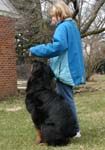
The Automatic Sit - would you like your dog to sit nicely, in heel position, whenever you stop without even being asked? That is the Automatic Sit. To teach this (I would wait until you are up to at least 8 steps or so) simply take a a couple slower, smaller steps before you stop, and as you take the last steps use a treat in your hand to lure him up into a sit. Give a treat. No verbal command is needed. When he is starting to sit promptly for his treat, then test it - slow down into a stop and wait.... If he does sit (he may need to think about it for a few moments - be patient!!) then treat, giving a jackpot! If he doesn't sit, then continue walking for a few steps and try again. If that happens several times in a row perhaps you need to continue luring him on the sit a few more times to help him know what is expected. Don't worry if the sits aren't perfectly straight at first - you can shape them into being more precise later if you like. When you do stop, be sure to stand up straight & bring both feet together. This will help your dog to distinguish a true "halt" (when he should sit) from a pause for a treat (when you are in mid stride and likely leaning over a little bit). Be careful not to rely on the lure very long for the sit (or anything else, for that matter) or you will be stuck with it. You also want to be sure to continue to treat actual walking as well as when you stop & he sits.
Need a way to walk your dog during the time it takes to teach Loose Leash Walking? I recommend a special harness called Easy Walk by the Premier Company (ask for it at pet supply stores) or order from JB Pet Supplies from the image link below. This harness is an instant cure (but it only works when on).What is different about this harness is that the leash clips in front of the harness. When the dog starts to pull, the harness actually starts to turn him towards you, very effectively ending the pulling. If the harnes is not enough, or if you dog is showing any aggression while out walking, then buy a head halter instead. This are by far the most effective training tools (far more ffective then prong collars), but you will likely need to take some time to acclimate your dog to the feel of the halter on his head. They do not cause any pain at all, but do feel funny at first. So when you put it on him the first few times, be ready to distract him with tasty treats and keep moving so he stops thinking about it. You must keep a light touch on the leash when using a head halter - do not hang onto it! My favorite brands are the Comfort Halter and the Gentle Leader.
Even with a dog who normally walks very nicely next to me, there are times when I really need to be sure, such as in my vet's waiting room. On those occasions, I will usually have a juicy treat & just lure my dog into the office. That keeps her focused on me instead of on the other waiting pets.
Lastly, what about that Flexi-leads? Hang onto it for when your dog is older and has the whole walking nicely thing down pat. They can be a lot of fun at the park, in areas where there aren't other dogs around to get tangled in it.
Happy Walking!
Need a way to walk your dog during the time it takes to teach Loose Leash Walking? I recommend a special harness called Easy Walk by the Premier Company (ask for it at pet supply stores) or order from JB Pet Supplies from the image link below. This harness is an instant cure (but it only works when on).What is different about this harness is that the leash clips in front of the harness. When the dog starts to pull, the harness actually starts to turn him towards you, very effectively ending the pulling. If the harnes is not enough, or if you dog is showing any aggression while out walking, then buy a head halter instead. This are by far the most effective training tools (far more ffective then prong collars), but you will likely need to take some time to acclimate your dog to the feel of the halter on his head. They do not cause any pain at all, but do feel funny at first. So when you put it on him the first few times, be ready to distract him with tasty treats and keep moving so he stops thinking about it. You must keep a light touch on the leash when using a head halter - do not hang onto it! My favorite brands are the Comfort Halter and the Gentle Leader.
Even with a dog who normally walks very nicely next to me, there are times when I really need to be sure, such as in my vet's waiting room. On those occasions, I will usually have a juicy treat & just lure my dog into the office. That keeps her focused on me instead of on the other waiting pets.
Lastly, what about that Flexi-leads? Hang onto it for when your dog is older and has the whole walking nicely thing down pat. They can be a lot of fun at the park, in areas where there aren't other dogs around to get tangled in it.
Happy Walking!
|
Introduction
Charging the Clicker Targeting Sit, Down, Stand Sit, Down, Stay Leash Walking Recall Wait Nail Clipping Leave It |


